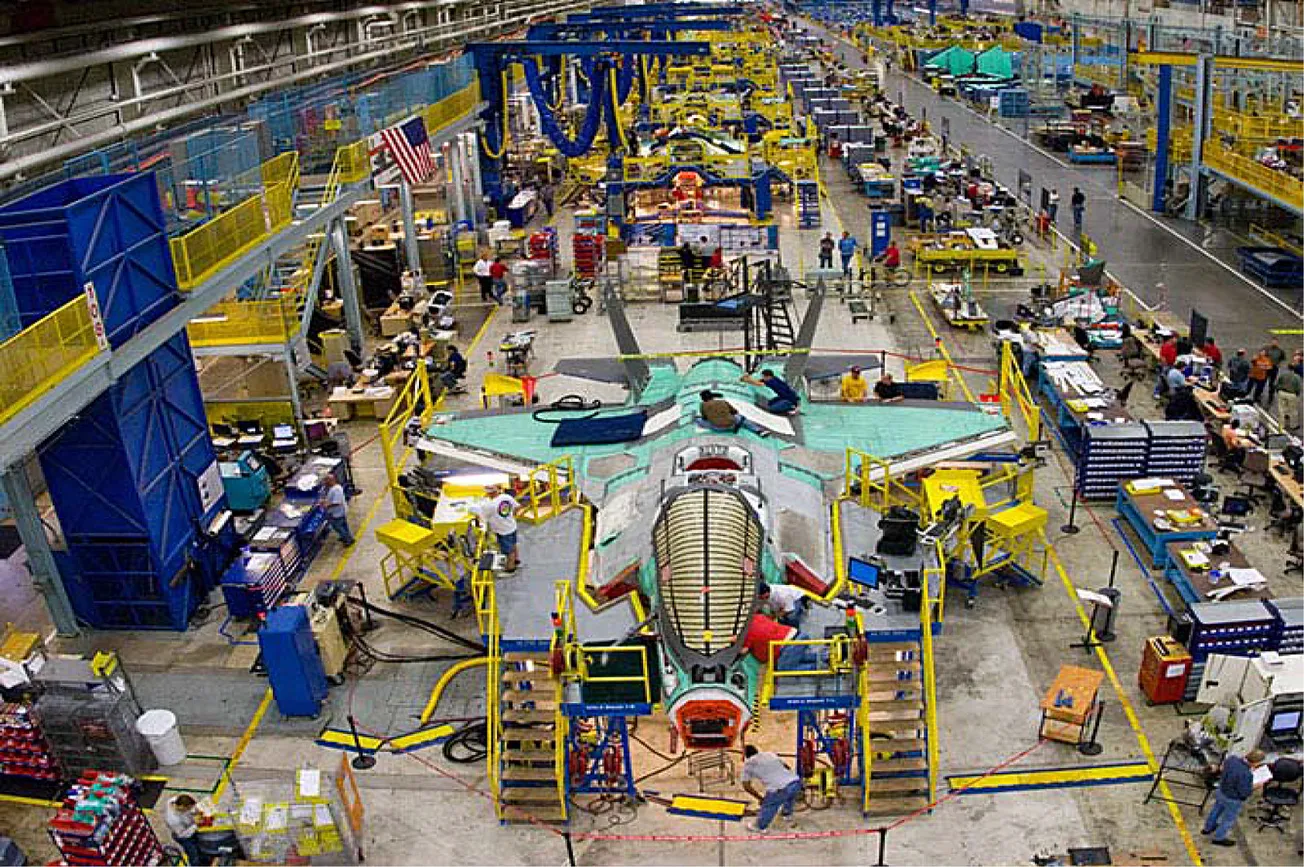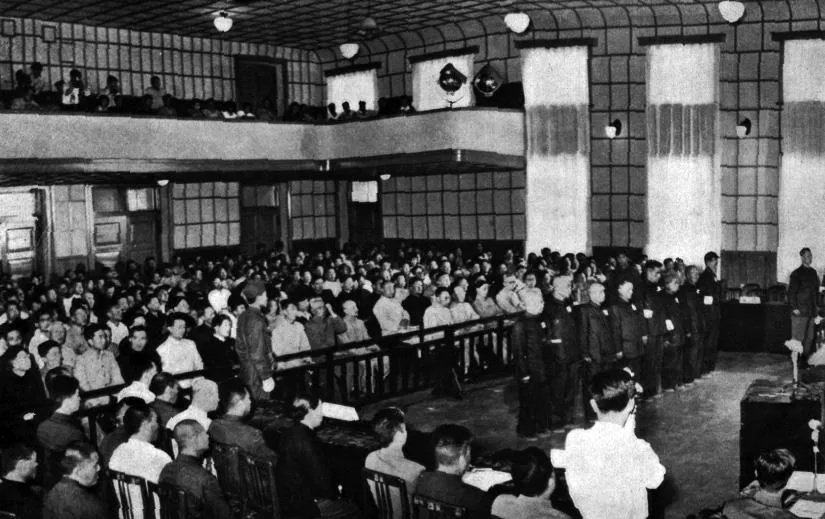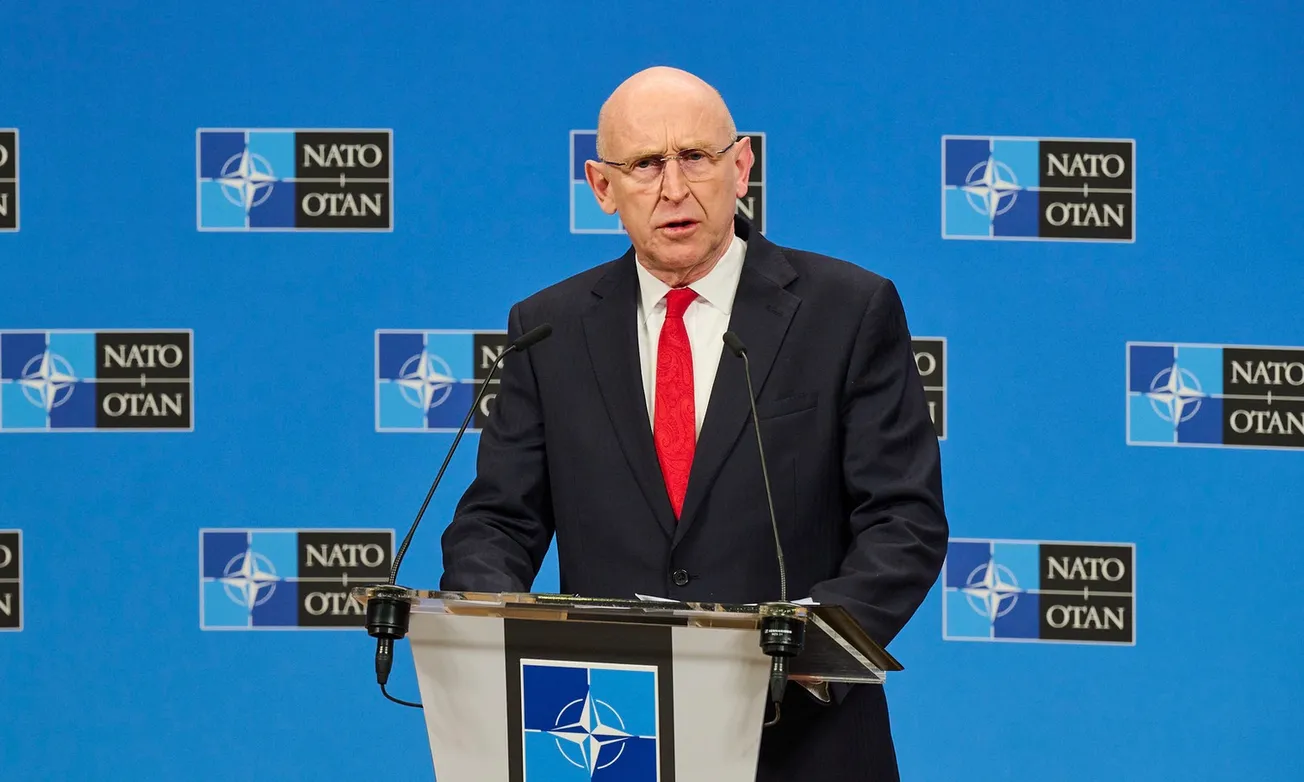The military-industrial complex (MIC) is the principal instrumentality by which the British-American financier class, centered in the City of London and Wall Street, are able to produce, supply, and operate weapons used to try to enforce the unipolar world order through war, militarily and financially. Taxpayers in the United States and NATO nations support vast sums of money thrown away annually in economic waste and physical destruction.
This revenue stream provides a tremendous bonanza to four Wall Street financial giants and the banks they partner with, who are the dominant stockholders of all the biggest producers of bombers and fighters, tanks and APCs, missiles and bombs, guided munitions and drones, artillery and shells, etc. The bonanza is realized by profits distributed as dividends, fees, and interest on loans made by their partner megabanks.
In his book, Understanding the War Industry, researcher and author Christian Sorenson states:
The big banks and investment firms are in actuality, the foremost propellants of the war industry’s influence.... When war corporations are merging or acquiring other corporations ... banks like Goldman Sachs and Morgan Stanley serve as financial advisors. The top five investors in shares of Lockheed Martin are giant financial firms.... They know war production is a reliable, steady investment.
Fact: The six largest U.S.-based weapons producers alone have $214 billion per year in global arms sales.
Fact: These six companies, in a typical recent year (2021), generated gross profits of $30.6 billion on $301 billion in revenues. Between 46% (Boeing) and 96% (Lockheed Martin) of those revenues came from selling weapons systems.
Fact: Taxpayers are now funding this flow of super-profits at the rate of $858 billion for the United States alone, in 2023 alone, and are paying interest on Treasury bonds which borrow much of that sum. Total debt interest is at a rate of more than $1 trillion per year right now.
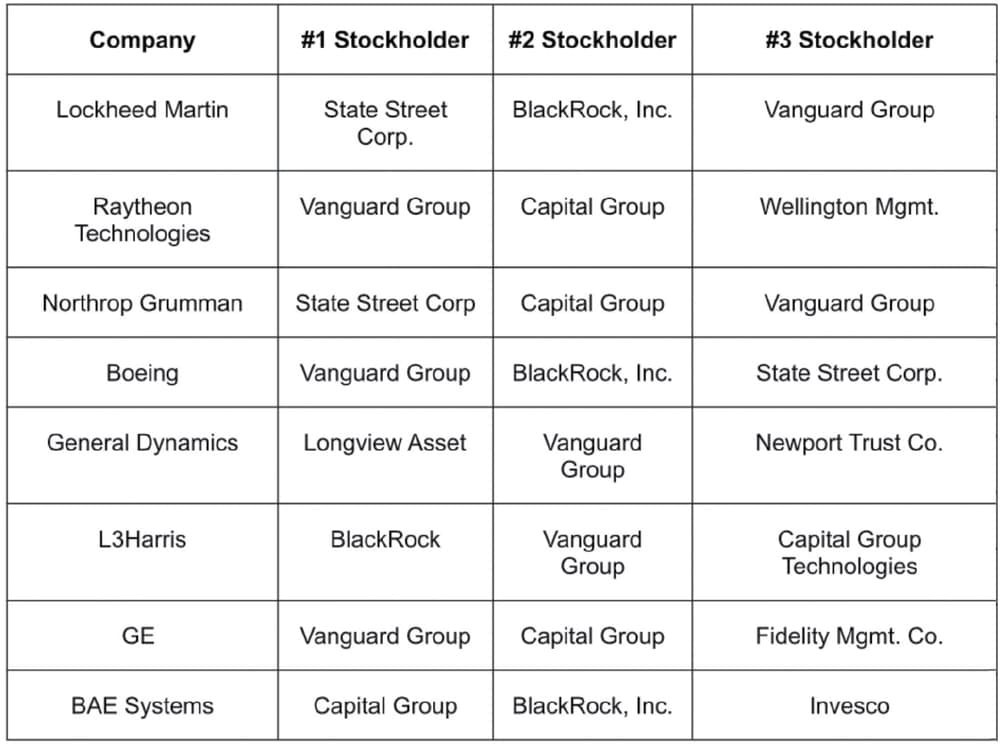
Fact: Four Wall Street investment firms are the top shareholders of all the arms giants, as shown in Table 1.
Table 2 shows the top 6 weapons firms with their most recent total annual defense revenues and the portion coming from defense.
Their combined annual revenue of $214 billion is 36% of total world military sales of $597 billion, determined by the Swedish International Peace Research Institute (SIPRI).
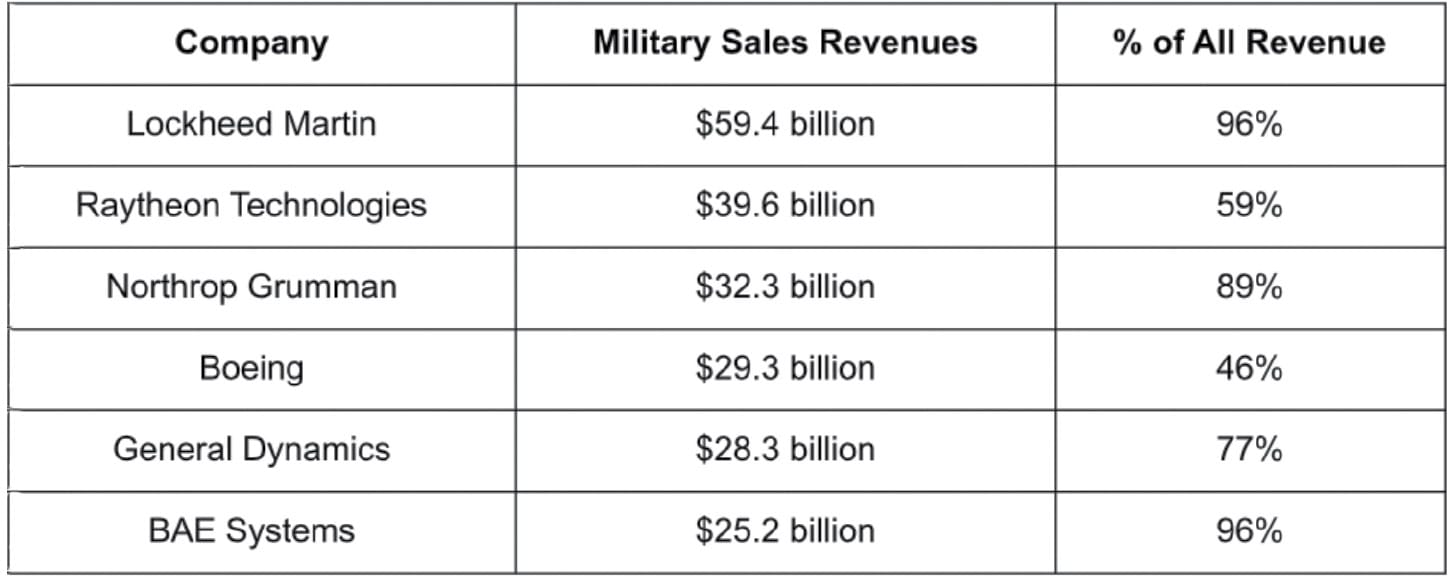
Turning Waste to Economic Progress
Fact: From 2001–2020, just the Overseas Contingency Operations/Global War on Terror (OCO/GWOT) Fund of the U.S. military budget—the fund which pays just for American armed forces deployed overseas in fighting the “endless wars,” totaled $2 trillion-plus. The OCO/GWOT did not go through normal Congressional approval procedures, which made it that much easier for the string of illegal foreign wars to be launched.
The military-industrial complex contains in its ranks some of the most advanced capital goods and sci-tech capabilities needed for the economic reconstruction of the developing countries—and the infrastructure transformation of the United States.
It is time to put an end to the dangerous capability which is the MIC, and turn the swords into plowshares. This means both redirecting the financial resources into productive investment, but also reconverting and retooling the scientifically advanced portions of the military firms to produce an array of infrastructure, advanced space programs, fusion reactors.
Fact: With that $2 trillion OCO/GWOT fund from 2001–2020, we could have built a 42,000-mile network of electrified, high-speed/maglev rail across the United States, as called for by Lyndon LaRouche and EIR, at a construction cost of approximately $500 billion; built the North American Water and Power Alliance (NAWAPA), at a cost of $400 billion; and set up $200 billion corporations modeled on the World War II Defense Plants Corporation, for nuclear fission, nuclear fusion, and a Moon-Mars project development. And there would have been funds as well to build schools, hospitals, clean water systems, and more.
Fact: The cost of a single B21 “Raider” nuclear bomber (about $800 million) now being built by Grumman Aerospace, is nearly enough for that same company to complete the $935 million main module of the Lunar Gateway orbiting space station (the “HALO Module”) a quarter million miles out into space, as the crucial stepping stone of the Artemis Moon-Mars mission of NASA.
Fact: With the funds lavished on General Electric Company (GE) to build the engines for the F-Series of fighter-bombers, including the newest F35A, F35B, and F35C (overall, a series of fighter-bombers costing more than $1 trillion), one of its subsidiaries, GE/Hitachi Nuclear Energy (GEH), could be building its small modular nuclear reactor prototype, the BWRX-300 reactor, for power and desalination of water in desert areas throughout Southwest Asia—including in the rebuilding of Palestinian territories—and in the desertifying areas of western North America.
Fact: Lockheed Martin designs, builds, and tests lunar and deep space exploration capabilities, including NASA’s Orion spacecraft, and creates early-warning weather and climate observation satellites, like the GOES-R series. As of January 2022, Lockheed Martin had approximately 115,000 employees worldwide, including about 60,000 engineers and scientists, i.e., more than half its total workforce.
Fact: The cost of building a 120-bed hospital is approximately $300 million; and the average cost to build a new school is approximately $45 million (including land acquisition, science labs in high schools, and so forth). How many thousands of hospitals and schools could be built, in the U.S. and throughout the world, with the annual MIC budget?
‘A Theft from Those Who Hunger …’
President Dwight Eisenhower famously coined the phrase “military-industrial complex” in his farewell address on Jan. 17, 1961:
We have been compelled to create a permanent armaments industry of vast proportions…. This conjunction of an immense military establishment and a large arms industry is new in the American experience…. Yet we must not fail to comprehend its grave implications.
Eight years earlier on April 16, 1953, Eisenhower had said:
Every gun that is made, every warship that is launched, every rocket fired, signifies in the final sense, a theft, from those who hunger, and are not fed, those who are cold, and are not clothed.… It is spending the sweat of its laborers, the genius of its scientists, the hopes of its children.
The enormous financial resources today being wasted on military production must be repurposed to productive investment in this country and abroad, while its skilled scientific and engineering manpower, and its significant machine-tool and productive capabilities must be retooled for productive needs at home and abroad.
It’s time, once again, to beat swords into plowshares—high-tech plowshares.
Retooling Examples in Detail
Retool for the Oasis Plan: A major company profiting heavily from many military jet engine contracts, including the most expensive series of aircraft ever built, could be getting large advance contracts instead to build small modular nuclear reactors for desalination and power. The LaRouche “Oasis Plan,” to provide fresh water and new infrastructure throughout the region of Palestine and Israel, will need these reactors in this decade; so, too, will the huge task of desalinating water for the drought-plagued and slowly desertifying North American West.
General Electric Company (GE) has many multi-hundred-million-dollar or multi-billion-dollar military contracts for engines for fighter planes and bombers, tanks, APCs and other military vehicles. What stands out currently is a $975 million, 2023 contract for “next generation engines” for the F35A and F35C nuclear-capable fighter-bombers. The total costs for the F35 series of fighter-bombers over recent years has exceeded $1 trillion. Along with the B21 “Raider” bomber, these planes’ purpose is to be able to carry out a nuclear “first strike” and start a nuclear war.
GE has other contracts, for the F-series of fighter planes’ engines, including a $423 million 2023 contract for five years. And it is working on a $1.6 billion 2021 contract for engines for the F-15EX fleet. And so on, into the billions.
But GE/Hitachi (GEH) has also developed a small modular nuclear reactor, the BWRX-300, a 300 megawatt boiling water reactor, which it says can be built in 24–36 months. It is building one for Ontario Power Generation at Darlington, Ontario, expected to be delivering electricity to the grid before the end of this decade. Instead of GE building engines for nuclear bombers, GEH could contract for many more BWRX-300 reactors to desalinate water for the desert of Southwest Asia. Though the “Oasis Plan” must start with gas-powered turbine plants along new canals to rebuild quickly there when war is stopped, nuclear power is much more efficient in that it requires a much smaller stream of fuel.
Beat Swords into Space Stations: It appears that in U.S. federal budgets, spending to major aerospace-defense corporations for each B21 “Raider” bomber—ready to carry “tactical” nuclear bombs—roughly equals the spending for a major module of NASA’s Gateway lunar station, to orbit the Moon.
Northrop Grumman has both lead contracts. In July 2021 it received a $935 million contract to build the HALO Module (Habitation and Logistics Outpost), which together with a power and propulsion element will be the Lunar Gateway orbiting space station for the Artemis Moon-Mars mission. Grumman is having trouble with the HALO contract because it is fixed-price, and with design changes, Northrop Grumman is running over; in July 2023 it had to take a $36 million charge against its annual earnings as a result.
There is no such limit on the B21, however, which is not built on fixed-price contracts; there, contract amounts are guarded military secrets, but it is reported to cost the federal budget at least $750–800 million per plane. We can say, “at least,” because the predecessor, B2 bomber—also built by Northrop Grumman—reportedly cost something like $1 billion per plane. Some 20 of the B2s were delivered to the U.S. Air Force, each one having a cost in taxpayer dollars roughly equal to the contract for a fundamentally new space station main module, the first such to orbit the Moon.
The B21 is built to carry new B61-Mod12 “dial-a-yield” tactical nuclear bombs being produced for it.
Retooling, redirecting the military budget to beat swords into a grand new plowshare in space, is obvious for humanity, for the United States, and even for the companies involved.
The Largest Military Contractors, in Detail
1. Lockheed Martin (LM) is the producer of the F-35 stealth fighter, which is in production for the U.S. Air Force, U.S. Navy and U.S. Marine Corps, as well as for 16 other countries (including Israel, which is heavily using F-35s in its war on Gaza). Pentagon officials revealed during a Dec. 13 hearing of the House Subcommittee on Tactical Air and Land Forces that they shipped software updates to Israel for its F-35 fleet in the wake of the Oct. 7 Hamas attack and have continued to support Israel’s F-35s since. The F-35’s price per unit, including ancillary costs like depot maintenance, ranges from $100.3 million to $117.3 million for each F-35. The U.S. fields 450 F-35s and plans to produce 2,500 for domestic use and foreign sales. The U.S. General Accounting Office reports:
The F-35 Lightning II Joint Strike Fighter program remains DOD’s most expensive weapon system program [ever]. It is estimated that it will cost over $1.7 trillion to buy, operate, and sustain these aircraft.
LM is also the producer of the F-16 fighter jet, which also makes up a large proportion of Israel’s air force, and of the AGM-114 Hellfire missile, the main armament of Apache attack helicopters, also flown by Israel. “Some 2,000 Hellfire missiles were delivered to Israel sometime between Oct. 7 and Nov. 14,” reported the American Friends Service Committee Action Center on Corporate Accountability. LM also produces the HIMARS rocket system, dozens of which have been shipped to Ukraine, and is the prime contractor for the Sentinel ICBM.
LM also produces the Javelin, a portable anti-tank defense system, more than 10,000 of which have been shipped to Ukraine by the U.S. government. One Javelin system costs $178,000, including the launch system and missile, according to the Pentagon’s 2021 budget. Each replacement missile costs around $78,000.
Other products include: the JASSM, one of Lockheed Martin’s first and most long-range cruise missiles; the Trident II D5, the latest generation of the U.S. Navy’s submarine-launched fleet ballistic missile; and a number of military products strictly for the British military, including the Royal Navy’s CROWSNEST Airborne Surveillance and Control (ASaC) program. Lockheed Martin maintains 20,000 square meters of state-of-the-art production facilities in the United Kingdom.
2. Raytheon Technologies (RTX) is the world’s largest missile maker. Its long list of products includes many types of air-to-surface and air-to-air missiles, the Tomahawk cruise missile, and the several types of missiles used by the U.S. Navy’s Aegis combat system. It also builds the SPY-6 air and missile defense radar for the U.S. Navy and the TPY-2 radar for the U.S. Army’s THAAD anti-missile system. RTX also manufactures the interceptor missiles for Israel’s Iron Dome anti-rocket system. A batch of these missiles was recently transferred to Israel from the U.S. Raytheon missiles that have been shipped to Ukraine include the Patriot, AIM-120 AMRAAM, Sidewinder air-to-air, Javelin anti-tank, and Stinger anti-aircraft missiles, among others.
3. Northrop Grumman is the prime contractor for the B-21 stealth bomber, which just flew its first flight in November. It also supplies the Israeli Air Force with the Longbow missile delivery system for its Apache attack helicopters and laser weapon delivery systems for its fighter jets. It has also supplied the Israeli Navy with Sa’ar 5-class warships, which have participated in the assault on Gaza. Northrop Grumman also produces many types of artillery and other ballistic ammunition, as well as rocket motors for, among other products, the ammunition used in Lockheed Martin’s HIMARS.
4. Boeing is the manufacturer of the Apache attack helicopter and the F-15 fighter jet, both of which Israeli forces have been using heavily in Gaza. Boeing also manufactures the GBU-39 Small Diameter Bomb—a 250 lb., GPS-guided air dropped munition, and the Joint Direct Attack Munition or JDAM—a GPS guidance kit used to turn unguided “dumb” bombs into precision guided weapons. Stated the American Friends Service Committee in a recent report published by its Action Center on Corporate Accountability:
Immediately after Oct. 7, Boeing expedited delivery of 1,000 smart bombs, and another 1,800 JDAM kits, to Israel. Both deliveries were part of a 2021 order that Israel made during its previous large-scale attack on Gaza.
A ground launched version of the Small Diameter Bomb has also been supplied to Ukraine.
5. General Dynamics (GD) is the owner of submarine-builder Electric Boat of Groton, Connecticut. Electric Boat builds the Virginia-class nuclear powered attack submarine and will also be building the Columbia-class, nuclear-armed ballistic missile submarine. GD’s other products include 155mm artillery ammunition, large quantities of which have been supplied to both Israel and Ukraine, as well as casings for air-dropped bombs. GD is reported to be looking to open a munitions factory in Western Ukraine to produce 155mm artillery rounds.
6. L3Harris Technologies is a producer of command and control systems, communications, and avionics, including components for the F-35 and other electronic and space systems. L3Harris has deep business ties in Israel, including an attempt to buy the Israeli NSO spyware firm in 2022. The deal never went through, due to White House objections. L3Harris is supplying the VAMPIRE anti-drone system to Ukraine.


